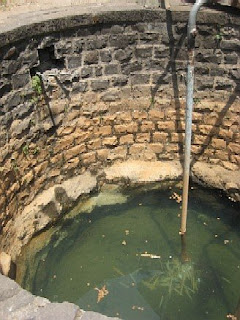
These days you can see the rocks properties of the aquifer at construction sites which excavate huge holes in the ground to put building foundations. The image below is taken at a construction site on flat ground and shows a very different profile than the first example.
The image shows a thick mature soil grading into a highly weathered basalt at the base. This highly weathered basalt forms the upper part of the aquifer. The weathered basalt grades into fresh basalt which may have horizontal joints like the one in the first photo or may be a more dense compact basalt with vertical joints. Its hard to find a location which shows the entire sequence and I have started taking my camera with me in the hope that a big construction site will show the entire aquifer profile. Meanwhile the figure below depicts the typical shallow aquifer system seen in the Deccan volcanic province.
 Source: ACWADAM
Source: ACWADAMI think its a lousy and dangerous idea to use this shallow water resource in the manner PMC is proposing to. The corporation simply intends to sink tube wells and install hand pumps and let citizens especially those living in slums access to this water without making any provisions for checking its quality. Unfortunately we know very little about the quality of this water. Likely sources of contamination are leaking and broken sewage pipes and seepage of surface pollutants.The section on groundwater in the environmental status report of the PMC shows that the water has not been screened for the presence of metals, microbes and even fecal matter which is very likely present especially in the groundwater underneath slums which often have no sanitation facilities. Without proper treatment any use of the water in the shallow aquifer constitutes a health hazard.
Pune is luckier than most big cities in India in having an adequate water supply during normal monsoon years. The PMC claims to supply about 200 liters per capita per day. This is much more than most cities in India. There are several big surface reservoirs with capacity to meet projected demands over the next few decades. Pune is growing fast and the problem in recent years has been the delays in setting up water supply infrastructure. Construction of water supply pipelines lags behind buildings, sometimes by years. Suburbs and shanty towns come up either without piped water facilities or with pipes too narrow to supply adequate water, leaving citizens dependent on groundwater which they extract from the deeper aquifer (100 feet or more) or buy from providers who tap it.
But the wild card in coming decades is the reliability of the monsoons. If rains become erratic due to climate change then Pune may be forced into tapping the shallow groundwater system to supplement surface water. This should not be done haphazardly like the current proposal. There needs to be a science backed plan which regulates not only the quality of water taken but also strikes a balance between extraction and replenishment. The deeper aquifer is already showing signs of degrading as unregulated extraction has resulted in an overdraft of several meters over the last decade. That means extraction exceeds natural replenishment with the result that ground water levels are falling year after year. The shallow aquifer if similarly exploited will also diminish quickly as a water resource.

No comments:
Post a Comment